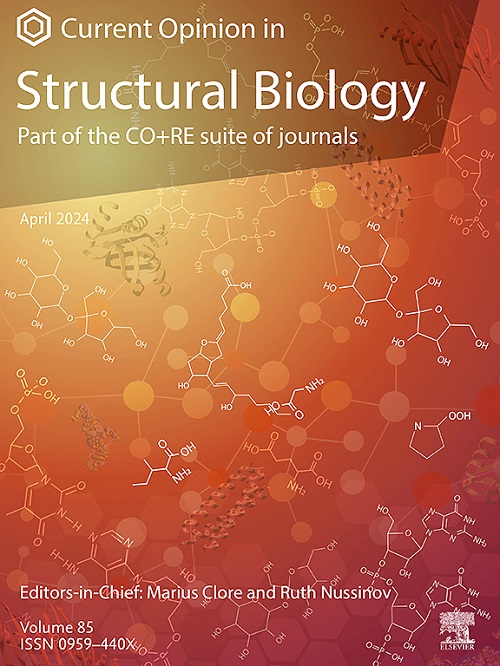捕获蛋白质动态跨越时间尺度与定点自旋标记电子顺磁共振波谱
IF 6.1
2区 生物学
Q1 BIOCHEMISTRY & MOLECULAR BIOLOGY
引用次数: 0
摘要
在蛋白质结构预测和测定的当前时代,解决结构转变的时间依赖性是一个令人兴奋的前沿。时间分辨生物物理技术具有直接实时观察生物分子动态结构变化的能力。在这里,我们回顾了位点定向自旋标记(SDSL)与电子顺磁共振(EPR)光谱结合的应用,涵盖了广泛的蛋白质动力学,从ps-ns时间尺度上的主链波动到ms-s时间尺度上的蛋白质复合物组装形成。SDSL EPR方法的最新发展允许在重要的μs-ms时间尺度上直接研究蛋白质构象交换动力学,为定义复杂生物现象的分子机制所需的结构转变提供了时间轴。本文章由计算机程序翻译,如有差异,请以英文原文为准。

Capturing protein dynamics across timescales with site-directed spin labeling electron paramagnetic resonance spectroscopy
In the current age of protein structure prediction and determination, resolving the time dependence of structural transitions represents an exciting frontier. Time-resolved biophysical techniques possess the capability to directly observe dynamic structural changes of biomolecules in real time. Here, we review applications of site-directed spin labeling (SDSL) coupled with electron paramagnetic resonance (EPR) spectroscopy that cover a broad range of protein dynamics, from backbone fluctuations on the ps–ns timescale to protein complex assembly formation on the ms–s timescale. Recent developments in SDSL EPR methods allow for direct investigation of protein conformational exchange kinetics on the important μs–ms timescale, providing the time axis for structural transitions needed to define molecular mechanisms of complex biological phenomena.
求助全文
通过发布文献求助,成功后即可免费获取论文全文。
去求助
来源期刊

Current opinion in structural biology
生物-生化与分子生物学
CiteScore
12.20
自引率
2.90%
发文量
179
审稿时长
6-12 weeks
期刊介绍:
Current Opinion in Structural Biology (COSB) aims to stimulate scientifically grounded, interdisciplinary, multi-scale debate and exchange of ideas. It contains polished, concise and timely reviews and opinions, with particular emphasis on those articles published in the past two years. In addition to describing recent trends, the authors are encouraged to give their subjective opinion of the topics discussed.
In COSB, we help the reader by providing in a systematic manner:
1. The views of experts on current advances in their field in a clear and readable form.
2. Evaluations of the most interesting papers, annotated by experts, from the great wealth of original publications.
[...]
The subject of Structural Biology is divided into twelve themed sections, each of which is reviewed once a year. Each issue contains two sections, and the amount of space devoted to each section is related to its importance.
-Folding and Binding-
Nucleic acids and their protein complexes-
Macromolecular Machines-
Theory and Simulation-
Sequences and Topology-
New constructs and expression of proteins-
Membranes-
Engineering and Design-
Carbohydrate-protein interactions and glycosylation-
Biophysical and molecular biological methods-
Multi-protein assemblies in signalling-
Catalysis and Regulation
 求助内容:
求助内容: 应助结果提醒方式:
应助结果提醒方式:


